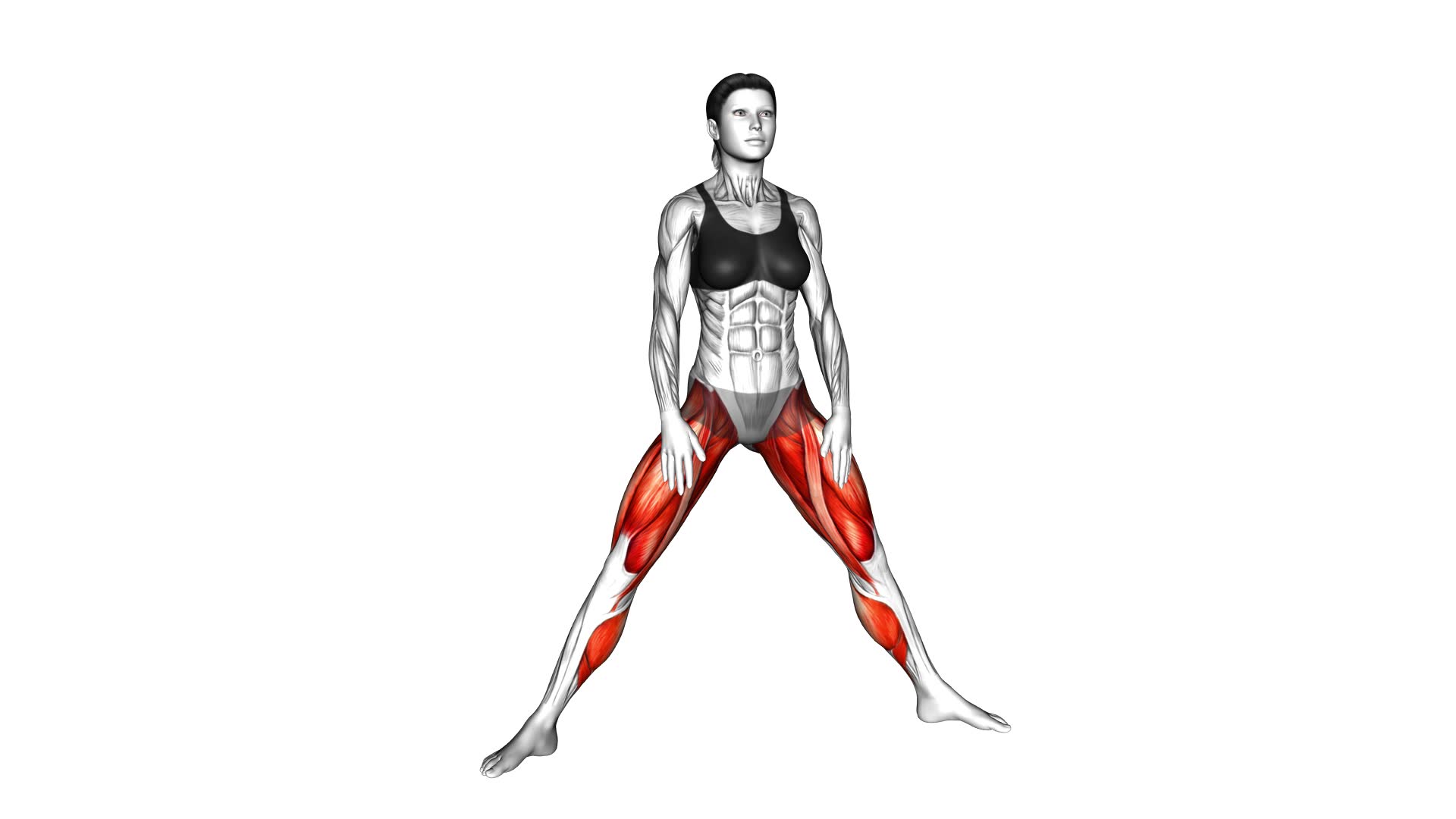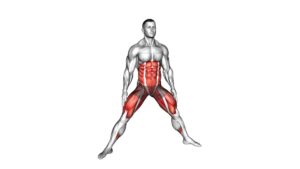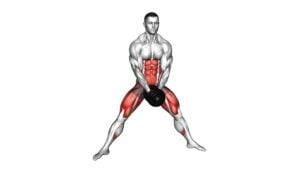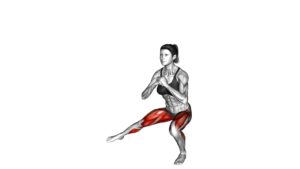Plyo Side Lunge Stretch (female) – Video Exercise Guide & Tips

Get ready to stretch and strengthen your body with the Plyo Side Lunge Stretch!
Watch This Exercise Video
In this video exercise guide, we'll show you how to perform this dynamic exercise, specifically designed for women.
By incorporating plyometric movements into your side lunges, you'll boost your cardiovascular endurance and engage multiple muscle groups.
Whether you're a beginner or advanced, this stretch offers variations and modifications to suit your fitness level.
Follow along and get ready to feel the burn!
Key Takeaways
- The Plyo Side Lunge Stretch improves lower body strength and flexibility.
- It targets multiple muscle groups in the lower body, including the glutes, hamstrings, quadriceps, and hip flexors.
- The exercise increases flexibility in the inner thigh and groin area.
- Proper form and technique, as well as listening to your body and gradually progressing, are crucial for safety and effectiveness.
Benefits of the Plyo Side Lunge Stretch
Experience the numerous benefits of the Plyo Side Lunge Stretch to improve your lower body strength and flexibility. This dynamic stretch targets multiple muscle groups in the lower body, including the glutes, hamstrings, quadriceps, and hip flexors. By incorporating the Plyo Side Lunge Stretch into your workout routine, you can expect to see improved flexibility and increased lower body strength.
The Plyo Side Lunge Stretch involves stepping to the side into a lunge position while simultaneously reaching down towards the foot with the opposite hand. This movement helps to lengthen and stretch the muscles in the inner thigh and groin area, promoting increased flexibility. Additionally, the explosive nature of the plyometric movement engages the muscles in the lower body, leading to greater strength gains.
Regularly performing the Plyo Side Lunge Stretch can have a positive impact on your overall athletic performance. It can improve your range of motion, allowing you to move more freely and efficiently during activities such as running, jumping, and squatting. The increased lower body strength gained from this exercise can also enhance your stability and power, making you less prone to injuries and improving your ability to perform explosive movements.
Incorporate the Plyo Side Lunge Stretch into your warm-up routine or as a standalone exercise to reap the benefits of improved flexibility and increased lower body strength.
Proper Form and Technique
To perform the Plyo Side Lunge Stretch with proper form and technique, start by standing with your feet shoulder-width apart. Keep your back straight and engage your core muscles. Begin by taking a big step to the side with your right foot, keeping your toes pointing forward. As you step, bend your right knee and lower your body into a lunge position. Make sure your knee is directly above your ankle and your thigh is parallel to the ground. Push off with your right foot and return to the starting position. Repeat on the other side.
To ensure proper form and technique, avoid these common mistakes. First, don't let your knee cave inwards or extend beyond your toes. This can put unnecessary strain on your knee joint. Second, don't lean forward or round your back. Maintain an upright posture throughout the movement. Lastly, don't rush the exercise. Focus on controlled movements and maintain proper alignment.
Once you have mastered the basic Plyo Side Lunge Stretch, you can try advanced variations. One option is to add a jump when returning to the starting position. This will increase the intensity and challenge your lower body muscles even more. Another variation is to hold a dumbbell or kettlebell in each hand to add resistance. This will help strengthen your upper body as well. Remember to always start with lighter weights and gradually increase as you become stronger.
Variations and Modifications
Try these three variations to add variety and challenge to your Plyo Side Lunge Stretch. If you're looking for alternative exercises, these variations will help you mix up your routine and target different muscles.
- Jumping Plyo Side Lunge: To increase the intensity of your side lunge stretch, add a jump. Start in a standing position with your feet together. Jump to the side, landing in a deep side lunge position. Keep your chest lifted and your core engaged. Push off with your front foot and jump back to the starting position. Repeat on the other side. This advanced variation adds a plyometric element, increasing your power and cardiovascular endurance.
- Weighted Plyo Side Lunge: For an extra challenge, grab a pair of dumbbells or a kettlebell. Hold the weight in front of your chest with both hands. Step out into a side lunge and lower down while keeping your back straight. Push off with your front foot and return to the starting position. The added resistance will engage your muscles even more, helping to build strength and tone.
- Lateral Plyo Side Lunge: Instead of stepping to the side, try jumping laterally. Start in a standing position with your feet together. Jump to the side, landing in a wide side lunge position. Keep your chest lifted and your core engaged. Push off with your front foot and jump back to the starting position. This variation adds a dynamic element to the exercise, challenging your balance and coordination.
Incorporating these advanced variations into your Plyo Side Lunge Stretch routine will help you progress and continue challenging your body. Remember to listen to your body and only perform exercises that are appropriate for your fitness level.
Tips for Beginners
To get started with the Plyo Side Lunge Stretch, beginners can follow these tips for proper form and technique:
- Start Slow: It's important for beginners to take their time and start with a slow and controlled movement. Rushing through the exercise can lead to poor form and potential injuries. Take the time to understand the proper technique before increasing the speed or intensity.
- Maintain Balance: One common mistake beginners make is losing their balance during the side lunge stretch. To avoid this, focus on keeping your weight evenly distributed between both feet. Engage your core muscles and keep your chest lifted to help maintain stability throughout the exercise.
- Avoid Overextending: Another common misconception is that the deeper the lunge, the better the stretch. However, overextending your knee or hip can put unnecessary strain on the joints and increase the risk of injury. Instead, focus on a comfortable range of motion that allows you to feel a stretch in your inner thigh without any pain or discomfort.
Precautions and Safety Guidelines
As you continue with the Plyo Side Lunge Stretch, it's crucial to adhere to certain precautions and safety guidelines to ensure a safe and effective workout. By following these guidelines, you can minimize the risk of injury and maximize the benefits of this exercise.
Firstly, it's important to avoid common mistakes that can lead to injury. One common mistake is failing to maintain proper form throughout the exercise. Make sure to keep your back straight, chest lifted, and knees aligned with your toes. Avoid leaning forward or rounding your back, as this can strain your lower back and knees.
Additionally, it's recommended to perform a warm-up routine before starting the Plyo Side Lunge Stretch. This will help prepare your muscles and joints for the exercise, reducing the risk of strains or sprains. Some recommended warm-up exercises include jogging in place, jumping jacks, or dynamic stretches like leg swings and arm circles.
Lastly, listen to your body and start with a comfortable range of motion. If you feel any pain or discomfort, modify the exercise or stop if necessary. It's always better to start slowly and gradually increase the intensity as your body becomes more accustomed to the movement.
Frequently Asked Questions
Can I Perform the Plyo Side Lunge Stretch if I Have Knee or Hip Pain?
If you're experiencing knee or hip pain, it's best to avoid the plyo side lunge stretch. This exercise puts a lot of stress on those areas and could potentially worsen your pain.
Instead, consider modifying the exercise by performing a regular side lunge without the jumping motion. This will still engage your muscles without putting excessive strain on your joints.
Additionally, there are alternative stretches available that specifically target knee and hip pain, which you may find more beneficial.
How Many Repetitions Should I Do When Performing the Plyo Side Lunge Stretch?
When performing the plyo side lunge stretch, it's important to consider how many repetitions you should do. To determine this, you can start with a lower number, like 8 to 10 repetitions per set, and gradually increase as you get more comfortable.
It's also helpful to modify the exercise for beginners by performing a regular side lunge without the plyo jump.
Incorporating the plyo side lunge stretch into your workout routine can provide benefits such as improved lower body strength and flexibility.
Can I Do the Plyo Side Lunge Stretch if I Have Limited Flexibility?
If you have limited flexibility, there are modifications you can make to the Plyo Side Lunge Stretch. You can try reducing the range of motion or performing the exercise at a slower pace.
Additionally, there are alternative stretches that can help improve flexibility, such as the seated side stretch or the standing quad stretch.
It's important to listen to your body and work within your comfort level to avoid any potential injuries.
Is It Normal to Feel Discomfort or Soreness After Performing the Plyo Side Lunge Stretch?
Feeling discomfort or soreness after doing the plyo side lunge stretch is normal. This stretch targets multiple muscle groups and can cause some muscle fatigue.
However, if the discomfort or soreness is severe or lasts for an extended period, it's a good idea to consult a healthcare professional.
Remember to listen to your body and modify the stretch as needed to avoid any excessive strain or injury.
Can I Incorporate Weights or Resistance Bands Into the Plyo Side Lunge Stretch for an Added Challenge?
To add some extra challenge to your plyo side lunge stretch, you can definitely incorporate weights or resistance bands. Using weights, like dumbbells or kettlebells, can increase the resistance and make your muscles work harder.
Resistance bands can also be a great addition, as they provide constant tension throughout the movement. Just make sure to choose a weight or resistance level that challenges you, but still allows you to maintain proper form and technique.
Conclusion
In conclusion, the plyo side lunge stretch is a beneficial exercise that helps improve flexibility and strength in the lower body.
By following proper form and technique, variations and modifications can be incorporated to suit individual needs and fitness levels.
Beginners should start with caution and gradually increase intensity.
It's important to prioritize safety and follow precautions to avoid any injuries during the exercise.
Incorporating this stretch into your routine can help enhance overall fitness and athletic performance.

Author
Years ago, the spark of my life’s passion ignited in my mind the moment I stepped into the local gym for the first time. The inaugural bead of perspiration, the initial endeavor, the very first surge of endorphins, and a sense of pride that washed over me post-workout marked the beginning of my deep-seated interest in strength sports, fitness, and sports nutrition. This very curiosity blossomed rapidly into a profound fascination, propelling me to earn a Master’s degree in Physical Education from the Academy of Physical Education in Krakow, followed by a Sports Manager diploma from the Jagiellonian University. My journey of growth led me to gain more specialized qualifications, such as being a certified personal trainer with a focus on sports dietetics, a lifeguard, and an instructor for wellness and corrective gymnastics. Theoretical knowledge paired seamlessly with practical experience, reinforcing my belief that the transformation of individuals under my guidance was also a reflection of my personal growth. This belief holds true even today. Each day, I strive to push the boundaries and explore new realms. These realms gently elevate me to greater heights. The unique combination of passion for my field and the continuous quest for growth fuels my drive to break new ground.







